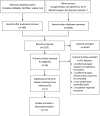Global Postural Reeducation for patients with musculoskeletal conditions: a systematic review of randomized controlled trials
- PMID: 27437710
- PMCID: PMC4946835
- DOI: 10.1590/bjpt-rbf.2014.0153
Global Postural Reeducation for patients with musculoskeletal conditions: a systematic review of randomized controlled trials
Abstract
Objectives: To systematically review randomized controlled trials that assessed the effects of Global Postural Reeducation (GPR) on patient-reported outcomes in conditions of the musculoskeletal system.
Method: An electronic search of MEDLINE (via PubMed), EMBASE, Cochrane CENTRAL, and SciELO was performed from their inception to June 2015. Randomized controlled trials that analyzed pain and patient-reported outcomes were included in this review. The Cochrane Collaboration's Risk of Bias Tool was used to evaluate risk of bias, and the quality of evidence was rated following the GRADE approach. There were no language restrictions.
Results: Eleven trials were included totaling 383 patients. Overall, the trials had high risk of bias. GPR was superior to no treatment but not to other forms of treatment for pain and disability. No placebo-controlled trials were found.
Conclusion: GPR is not superior to other treatments; however, it is superior to no treatment. Due to the lack of studies, it is unknown if GPR is better than placebo. The quality of the available evidence ranges from low to very low, therefore future studies may change the effect estimates of GPR in musculoskeletal conditions.
Figures


References
-
- Ferrari S, Vanti C, O’Reilly C. Clinical presentation and physiotherapy treatment of 4 patients with low back pain and isthmic spondylolisthesis. J Chiropr Med. 2012;11(2):94–103. http://dx.doi.org/10.1016/j.jcm.2011.11.001 - DOI - PMC - PubMed
-
- Ribeiro F, Leite M, Silva F, Sousa O. Physical exercise in the treatment of Ankylosing Spondylitis: a systematic review. Acta Reumatol Port. 2007;32(2):129–137. - PubMed
-
- Gyurcsik ZN, Andras A, Bodnar N, Szekanecz Z, Szanto S. Improvement in pain intensity, spine stiffness, and mobility during a controlled individualized physiotherapy program in ankylosing spondylitis. Rheumatol Int. 2012;32(12):3931–3936. http://dx.doi.org/10.1007/s00296-011-2325-9 - DOI - PubMed
-
- Cunha AC, Burke TN, Franca FJ, Marques AP. Effect of global posture reeducation and of static stretching on pain, range of motion, and quality of life in women with chronic neck pain: a randomized clinical trial. Clinics (Sao Paulo) 2008;63(6):763–770. http://dx.doi.org/10.1590/S1807-59322008000600010 - DOI - PMC - PubMed
-
- Maluf SA, Moreno BG, Crivello O, Cabral CM, Bortolotti G, Marques AP. Global postural reeducation and static stretching exercises in the treatment of myogenic temporomandibular disorders: a randomized study. J Manipulative Physiol Ther. 2010;33(7):500–507. http://dx.doi.org/10.1016/j.jmpt.2010.08.005 - DOI - PubMed
Publication types
MeSH terms
LinkOut - more resources
Full Text Sources
Other Literature Sources
Medical
